Crack climbing is a specialized form of rock climbing that involves ascending cracks in the rock face using various techniques and movements. It is a popular and challenging discipline within the climbing community, attracting both seasoned climbers looking for a new thrill and beginners eager to test their skills on unique terrain. The appeal of crack climbing lies in its diverse range of crack types, each presenting its own set of physical and mental challenges.
Originating as a necessity for protection during early climbs, crack climbing has evolved into a distinct style of climbing with its own set of techniques and equipment. Pioneered by legendary climbers like Layton Kor and Royal Robbins, crack climbing has developed into an art form that demands strength, finesse, and endurance. As climbers seek out iconic crack routes around the world, such as “The Nose” on El Capitan in Yosemite Valley, the allure of crack climbing continues to grow.
From finger cracks to off-widths, crack climbers encounter a variety of challenges that test their skill level and push their limits. The use of specialized gear like cams, nuts, gloves, and shoes designed for crack climbing is essential for safely navigating these unique features in the rock face. In the following sections, we will delve deeper into the history, types of cracks, gear requirements, techniques, training tips, top destinations, and safety precautions related to this exhilarating sport.
History of Crack Climbing
Crack climbing has a rich history that dates back to the early days of rock climbing. This style of climbing involves ascending cracks or fissures in the rock face using specific techniques and equipment. The roots of crack climbing can be traced back to traditional climbing, where climbers relied on placing removable protection like nuts and cams into the cracks for safety as they ascended.
Key pioneers in the world of crack climbing include names like Royal Robbins, Warren Harding, and Tom Frost, who made significant contributions to the sport during the Golden Age of Yosemite climbing in the 1950s and 1960s. These climbers were instrumental in pushing the boundaries of crack climbing by establishing groundbreaking routes on iconic formations such as El Capitan and Half Dome.
As crack climbing continued to evolve, new techniques and gear were developed to tackle different types of cracks. From thin finger cracks that require delicate jamming skills to wide off-width cracks that demand a variety of body positions, each type presents its own set of challenges for climbers. Understanding these nuances is crucial for successfully navigating various crack systems while maintaining balance and control on the wall.
- Royal Robbins
- Warren Harding
- Tom Frost
- Finger cracks
- Hand cracks
- Off-width cracks
Types of Cracks
There are various types of cracks that climbers encounter in their pursuits, each presenting unique challenges and requiring different techniques to navigate. One common type of crack is the finger crack, which is a thin, parallel fissure that requires precise jamming techniques with the fingers. Finger cracks can be particularly demanding due to the limited size and often sharp edges, making them a true test of a climber’s finger strength and endurance.
Another prevalent type of crack is the hand crack, which is wider than a finger crack and typically allows for jamming the entire hand inside. Hand cracks require different techniques compared to finger cracks, focusing more on maximizing the surface area of contact between the hand and the rock to maintain stability and progress upwards. Climbers often find hand cracks to be physically demanding but less technically challenging than finger cracks.
In addition to finger and hand cracks, climbers also encounter off-width cracks during their adventures. Off-width cracks are wider than a climber’s fist but narrower than an entire body width, making them awkward and challenging to climb.
Negotiating off-width cracks often involves using a combination of jams with different parts of the body, such as knees or elbows, as well as employing creative solutions to overcome the wide gaps. Overall, mastering off-width cracks requires both physical strength and mental determination due to their unconventional nature in comparison to other types of traditional crack climbing routes.
Gear for Crack Climbing
Crack climbing requires a specific set of gear to navigate the varying widths and shapes of cracks found in rock faces. Here is a breakdown of essential equipment needed for crack climbing:
- Cams: Also known as camming devices, these spring-loaded mechanical devices are crucial for protecting climbs in parallel-sided cracks. They can be placed in the crack and then expanded to hold securely in place, providing protection as climbers progress.
- Nuts: Nuts, also called stoppers or chocks, are passive protection devices inserted into constrictions or flaring cracks where cams might not fit. They work by wedging themselves into the crack when weighted, creating solid anchors for climbers.
- Gloves: Specialized crack climbing gloves can help protect your hands from cuts, scrapes, and abrasive surfaces when jamming your hands into rough cracks. These gloves provide extra grip and durability to withstand the harsh environment of crack climbing.
- Specialized Shoes: Climbing shoes designed specifically for crack climbing have stiffer soles and additional padding across the top of the foot to help cushion against the pressure of jamming your feet into cracks. The shoes should also offer good sensitivity for precise foot placements.
Ensuring you have the right gear before attempting crack climbing is essential for both performance and safety on the rock. By investing in quality equipment tailored to this challenging form of climbing, you can enhance your overall experience and tackle crack routes with confidence.
It’s important to remember that proper maintenance and inspection of your gear are crucial before each climb to ensure everything is in good working condition. By understanding how each piece of equipment functions and knowing when it needs replacement or repair, you can minimize risks while enjoying the exhilarating world of crack climbing.
Techniques for Crack Climbing
Crack climbing requires a unique set of techniques and movements that differ from other forms of climbing. Hand jams, foot jams, and liebacks are essential skills for successfully navigating cracks of varying widths and angles. Hand jams involve wedging the hands into the crack with the thumb up and fingers down, creating a secure hold. This technique allows climbers to offload weight from their arms and use their legs more effectively.
Foot jams are just as crucial in crack climbing, providing stability and balance while moving upward or placing gear. Climbers can use different foot jamming techniques depending on the size of the crack, such as toe jams in thin cracks or heel-toe cams in wider cracks. Proper foot jamming technique helps prevent slipping and conserves energy during climbs.
Additionally, mastering the art of liebacks is essential for tackling flaring or dihedral cracks. This technique involves using opposing pressure between the hands and feet to move upward when holds are limited.
As climbers progress in their crack climbing abilities, they learn to combine these techniques fluidly to efficiently ascend a variety of crack types. Developing these skills takes practice and patience, but once mastered, they open up a whole new realm of possibilities on the rock. Incorporating hand jams, foot jams, and liebacks seamlessly into a climbing sequence can turn what initially seems impossible into achievable challenges for even the most experienced climbers.
| Crack Climbing Techniques | Description |
|---|---|
| Hand Jams | Widging hands into the crack with thumb up and fingers down for secure hold. |
| Foot Jams | Providing stability & balance by wedging feet into the crack depending on its size. |
| Liebacks | Using opposing pressure between hands & feet to move upward in flaring cracks. |
Training for Crack Climbing
Crack climbing is a specialized form of rock climbing that requires unique skills, techniques, and strength to navigate vertical fissures in the rock face. Training for crack climbing is essential to improve your abilities and feel more confident tackling challenging routes both indoors and outdoors.
Whether you are a beginner looking to build a foundation or an experienced climber aiming to enhance your crack climbing prowess, incorporating specific tips and exercises into your training regimen can make a significant difference in your performance on the wall.
Building Finger Strength
One of the essential aspects of crack climbing is having strong fingers to maintain grip and support your body weight while jamming into cracks. Incorporate finger-strengthening exercises such as hangboarding, campus boarding, finger rolls, and pinch grips into your regular training routine. Additionally, practicing different hand positions and crack sizes in the gym can help develop the specific muscles needed for effective crack climbing.
Technique Workshops
Attending technique workshops focused on crack climbing can provide valuable insights and guidance from seasoned climbers. These workshops often cover essential techniques like hand jams, fist jams, finger locks, liebacks, foot stacks, and other advanced movements required for various crack sizes. Working with experienced instructors can help refine your skills, improve your efficiency on the rock face, and boost your confidence when tackling challenging cracks.
Outdoor Practice
While indoor gyms are excellent for honing basic crack climbing skills and strength-building exercises, nothing compares to practicing on real rock formations. Seek out local crags or climbing areas with diverse crack types to experience different challenges firsthand.
Outdoor practice not only helps translate indoor training into real-world scenarios but also allows you to appreciate the natural beauty of crack climbing destinations while sharpening your techniques in a more authentic setting. Remember always to prioritize safety when transitioning from indoor to outdoor climbing environments.
Top Crack Climbing Destinations
Crack climbing has garnered a dedicated following amongst rock climbers due to its unique challenges and rewarding experiences. The art of crack climbing involves using the natural fissures and fractures in the rock as handholds and footholds, requiring climbers to utilize specialized techniques and gear to navigate these vertical pathways. This form of climbing demands a combination of strength, technique, and mental fortitude, making it both physically and mentally demanding for those who dare to take on the cracks.
One of the most iconic crack climbing destinations in the world is Indian Creek in Utah. Known for its endless splitters – parallel-sided cracks that run continuously for great lengths – Indian Creek offers a playground for crack aficionados of all levels.
From finger cracks to wide off-widths, climbers can test their skills on a variety of crack sizes and styles amidst the stunning red sandstone cliffs of this renowned desert paradise. The consistent nature of the cracks at Indian Creek provides an ideal training ground for honing crack climbing techniques and building endurance.
Another must-visit destination for crack climbing enthusiasts is Yosemite Valley in California. Home to some of the most classic crack climbs in the world, including routes like The Nose on El Capitan and Separate Reality at Lover’s Leap, Yosemite offers a mecca for those seeking high-quality crack climbs in a breathtaking alpine setting.
Whether tackling splitter fingers or battling chimney squeezes, climbers flock to Yosemite year after year to test their mettle on some of the most revered crack lines in existence. With its rich history as a proving ground for legendary climbers past and present, Yosemite remains a premier destination for those looking to push their limits in the realm of crack climbing.
Safety Tips for Crack Climbing
Crack climbing is undoubtedly a thrilling and demanding form of rock climbing that attracts climbers seeking a challenging vertical adventure. The ability to navigate narrow fissures in the rock, utilizing specific techniques like hand jams and foot jams, adds an extra element of difficulty that sets crack climbing apart from other types of climbing.
As climbers ascend these natural fractures in the rock, they are met with varying widths and difficulties, requiring both physical strength and mental focus to overcome. Despite its challenges, crack climbing has gained popularity among climbers for the unique experience it offers.
Safety is paramount when engaging in crack climbing due to the nature of the terrain and the specific gear and techniques involved. Climbers must be well-equipped with protective gear such as cams, nuts, helmets, gloves, and specialized shoes designed for crack climbing. Additionally, proper training in crack-specific techniques is essential to minimize risks and enhance performance on routes. Understanding how to execute hand jams, foot jams, liebacks, and other movements effectively can prevent injuries while tackling challenging cracks.
To enjoy crack climbing responsibly, climbers must also be mindful of potential hazards such as loose rocks or poor rock quality that could compromise safety. Developing sound judgment regarding route selection based on personal skill level is crucial for a safe climbing experience.
Furthermore, maintaining open communication with climbing partners about safety protocols and emergency procedures can ensure a smooth ascent while minimizing risks inherent in crack climbing. By adhering to best practices for safety and responsibility in this exhilarating sport, climbers can fully embrace the unique challenges and rewards that crack climbing has to offer.
Frequently Asked Questions
What Does Crack Mean in Climbing?
Crack climbing in rock climbing refers to the technique of ascending a crack or fissure in the rock by wedging hands, feet, and sometimes entire body parts into the crevice to gain upward progress. It requires specialized skills like hand jams, finger locks, and laybacking to navigate these unique features on the rock.
How Do I Become a Better Crack Climber?
To become a better crack climber, one must practice regularly on various types of cracks to build muscle memory and improve technique. Learning different jamming techniques, such as hand jams and foot jams, is essential. Additionally, working on building strength in the hands, fingers, and forearms can be beneficial for handling the physical demands of crack climbing.
Where Did Crack Climbing Originate?
Crack climbing originated in traditional climbing areas like Yosemite Valley in California where climbers began mastering the technique in the early days of rock climbing. The rough granite walls of Yosemite provided ideal conditions for developing crack climbing skills, leading to its popularity among climbers seeking challenging routes that require technical expertise and physical endurance.
As climbers explored new areas around the world, they brought their knowledge of crack climbing with them, helping spread this unique style of climbing across different regions.

An avid outdoor enthusiast, writer, and environmental advocate who has spent over two decades exploring the world’s most breathtaking landscapes. With a background in environmental science and a passion for adventure, Frances combines her love for nature with her talent for storytelling to inspire others to embark on their own outdoor journeys.





